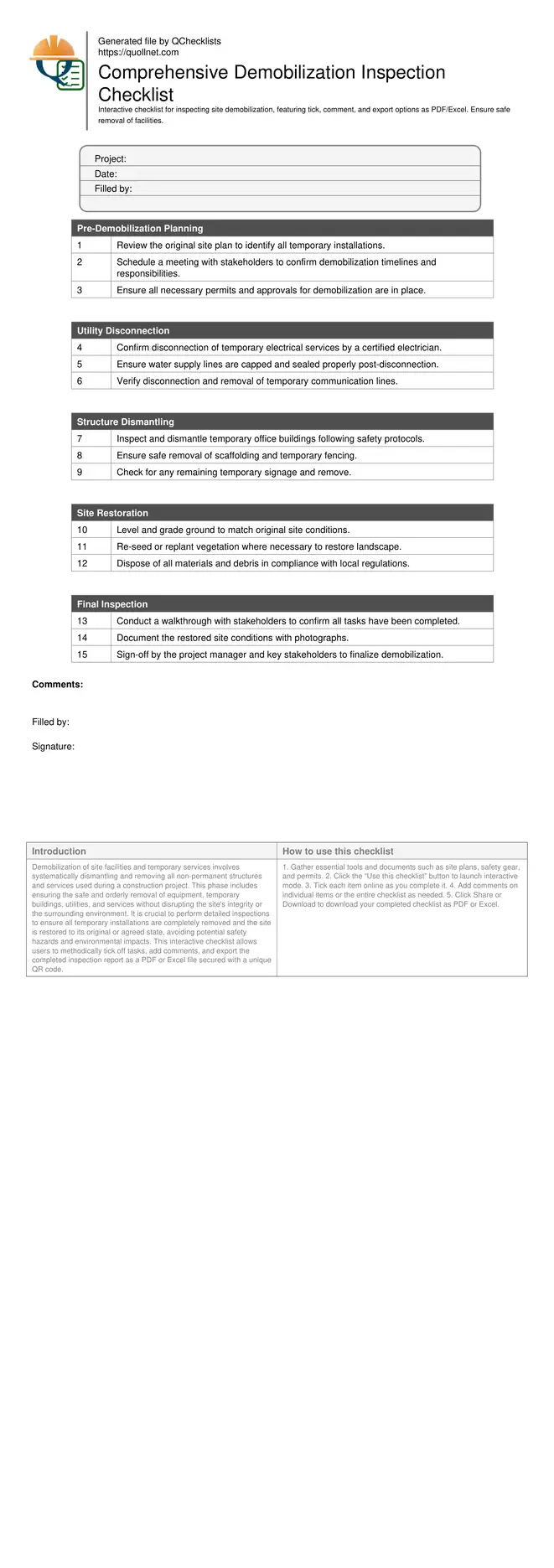Demobilization Inspection of Site Facilities and Temporary Services
Demobilization of site facilities and temporary services involves systematically dismantling and removing all non-permanent structures and services used during a construction project. This phase includes ensuring the safe and orderly removal of equipment, temporary buildings, utilities, and services without disrupting the site's integrity or the surrounding environment. It is crucial to perform detailed inspections to ensure all temporary installations are completely removed and the site is restored to its original or agreed state, avoiding potential safety hazards and environmental impacts. This interactive checklist allows users to methodically tick off tasks, add comments, and export the completed inspection report as a PDF or Excel file secured with a unique QR code.
- Ensure safe removal of temporary structures and services to prevent environmental impact.
- Verify complete site restoration to pre-construction conditions.
- Interactive online checklist with tick, comment, and export features secured by QR code.
- Facilitates compliance with safety and environmental regulations during demobilization.
Pre-Demobilization Planning
Utility Disconnection
Structure Dismantling
Site Restoration
Final Inspection
Importance of Thorough Demobilization
A thorough demobilization process is vital to ensure the project site is left in a safe and environmentally secure state. Failing to properly dismantle and remove temporary services can lead to safety hazards, legal liabilities, and environmental damage. This checklist helps ensure all aspects of demobilization are covered, minimizing disruptions and ensuring compliance with regulations.
- Prevents safety hazards by ensuring all structures are properly dismantled.
- Complies with environmental regulations and minimizes site impact.
- Ensures all stakeholders are aligned and responsibilities are clear.
- Facilitates an organized and efficient demobilization process.
Best Practices for Demobilization
Following best practices during demobilization not only ensures compliance with regulations but also enhances the efficacy and safety of the process. This includes detailed planning, stakeholder communication, and rigorous inspection of all dismantling activities. Implementing these best practices can streamline the process and avoid potential pitfalls.
- Conduct pre-demobilization planning and stakeholder meetings.
- Ensure all permits and approvals are secured before starting.
- Implement safety protocols during dismantling operations.
- Verify completeness of utility disconnections and site restoration.
How to Use the Demobilization Inspection Checklist
- Gather essential tools and documents such as site plans, safety gear, and permits.
- Click the “Use this checklist” button to launch interactive mode.
- Tick each item online as you complete it.
- Add comments on individual items or the entire checklist as needed.
- Click Share or Download to download your completed checklist as PDF or Excel.
Call to Action
- Start Checklist Tick off tasks, leave comments on items or the whole form, and export your completed report to PDF or Excel—with a built-in QR code for authenticity.
- Download Excel - Demobilization Inspection of Site Facilities and Temporary Services
- Download PDF - Demobilization Inspection of Site Facilities and Temporary Services
- View Image - Demobilization Inspection of Site Facilities and Temporary Services

